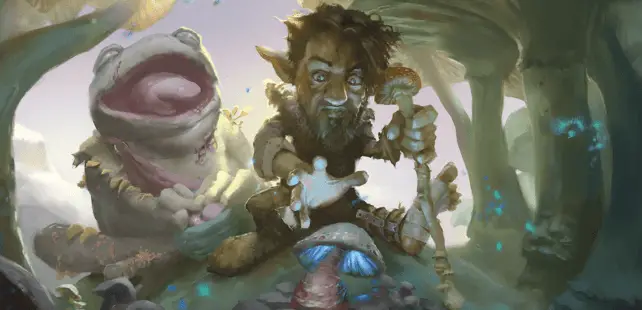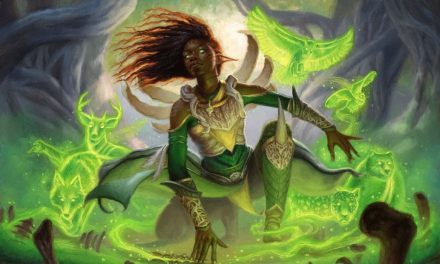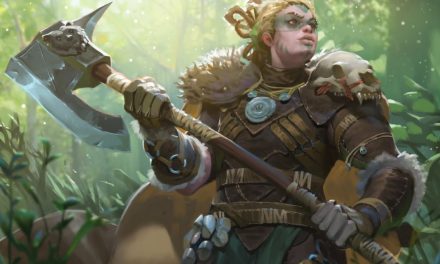Adventurers who want to show the party how much of a “fun guy” they are may choose to become a Circle of Spores Druid.
Ok, bad jokes aside…
This is quite possibly the most unique of the subclasses available to Druids in D&D 5e. In both theme and mechanics, it’s quite a departure from the typical Druid and can be deceptively complex.
But have no fear!
Let’s take a closer look and see what the undisputed champignon of Druid subclasses has to bring to the table.
Well, besides mushroom puns anyways…
This is the full guide to the Circle of Spores Druid in D&D 5e!
What Is the Circle of Spores Druid in D&D 5e?
Where others might see only rot, mold, and decay, some Druids see remarkable beauty and endless potential.
To them, death is simply one part of the cycle of life. Just as all living things are destined to die, new life is able to grow from that death. Rather than even viewing death as “the end”, Spores Druids view it as simply a change of states.
It might not be glamorous, but that’s nature for you!
In fact, they don’t even have a particular problem with the concept of undeath. Once again, it’s simply a different “state” to them.
It’s only when the undead seek to break the natural cycle (either by refusing to be laid to rest or by replacing all life with undeath) that Spores Druids begin to take issue.
Just like how colonies of mushrooms are endlessly complex, strange, and resilient, Spores Druids are much the same way.
The Circle of Spores Druid was originally published in Guildmaster’s Guide to Ravnica. It was then republished in Tasha’s Cauldron of Everything alongside the Circle of Stars and Circle of Wildfire Druid subclasses.
Role in the Party
Druids of this subclass thrive on the front lines, which makes the Shillelagh cantrip a must-have (if it wasn’t already.) They tend to be pretty tough and can use their Wild Shape to buff themselves further instead of changing form.
With their abilities to add extra damage from their Halo of Spores each round, reanimate enemies that die near them, and gain a healthy amount of temporary hit points with Symbiotic Entity, the Circle of Spores Druid is capable of both giving and taking heavy punishment.
All in all, Spores Druids can be deceptively tanky while also cranking out fairly consistent damage.
So expect to see the Spores Druid right on the front lines in melee combat. As they lay the smackdown on enemies with a combination of melee attacks, spores, and spells, they can throw a ton of pressure on their foes.
Spells that control the area or enemies (like Spike Growth and Entangle) are must-haves. Ideally, the Druid is also taking spells that help buff their ability to stand on the front line (like Healing Spirit, for example.)
Related: Guide to the Shillelagh Cantrip!
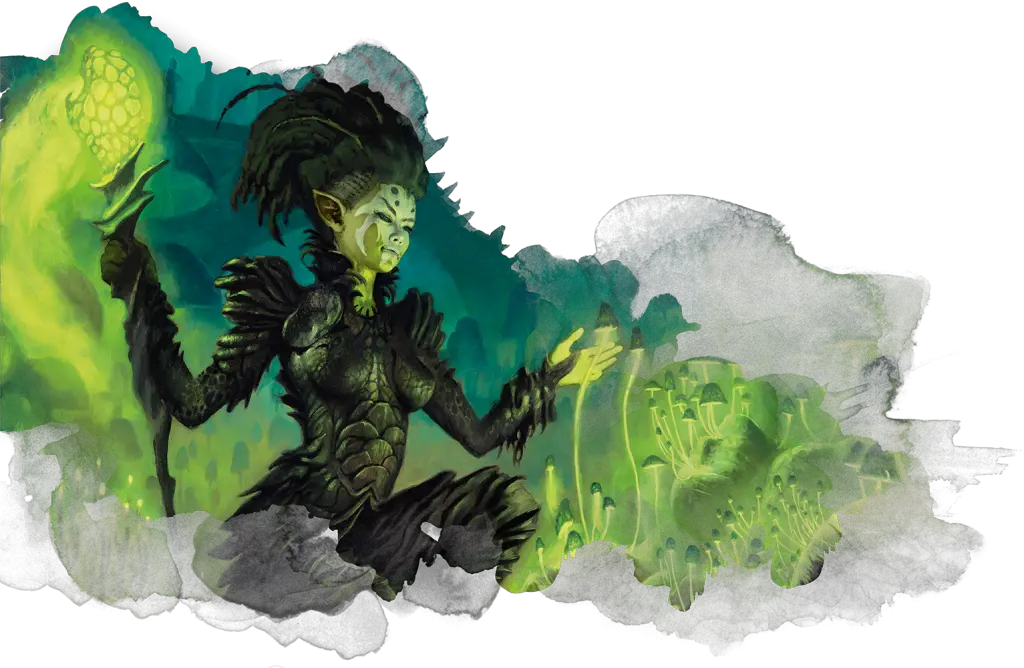
Circle of Spores Druid Abilities
The Circle of Spores Druid has arguably the most unique features of all of the Druid subclass options.
They take a bit of time to get everything moving just right and will need to pay close attention to their Action Economy. But when fights start to take more than just a couple of rounds, the Spores Druid can stand strong on the front lines.
Be aware that this is a complex subclass that makes a lot of demands on how you position yourself and use your turn.
Possibly more than any other subclass in D&D 5e, it’s important to have a clear idea of how your features work and make sure that you have a clear plan for how you’re going to be spending your turn.
Circle of Spores Spell List
First things first, you gain a selection of spells from the Circle of Spores.
These spells are always prepared and don’t count against the number of spells you can prepare each day. If you gain access to a spell that isn’t on the Druid Spell List, it counts as a Druid spell for you.
You gain each spell at the level shown in the table below.
| Druid Level | Spell |
| 2 | Chill Touch |
| 3 | Blindness/Deafness , Gentle Repose |
| 5 | Animate Dead , Gaseous Form |
| 7 | Blight , Confusion |
| 9 | Cloudkill , Contagion |
All in all, this is actually a pretty solid spell list with very few weak points.
Chill Touch is an excellent cantrip. While Shillelagh will largely be your “bread and butter”, this is a great backup to have in your pocket, especially if you are going up against undead.
You’ll likely get some good use out of Blindness/Deafness as a fairly reliable debuff to use against your foes. Don’t be shy with it and you’ll find yourself quickly getting advantage on your attacks against foes you blind with it.
Gentle Repose, on the other hand, is a bit more situational unless you find yourself regularly needing to preserve bodies.
With the focus on nature-based necromancy, of course, Animate Dead had to make it onto this list. Rather than typical zombies and skeletons, have fun flavoring your minions to fit the theme of this subclass. It’s hard not to immediately imagine the fungal zombies from The Last of Us with this class.
Gaseous Form can bring some handy utility. If you need to infiltrate or escape, it’s a nice trick to have ready.
As yet another fun debuff to inflict on enemies, Confusion makes sense here. It is a bit of an infamously unreliable spell, though, so be mindful that you might not get the best mileage out of it. But when you need to put out some extra damage, you’ve still got Blight!
It’s nice to see Cloudkill on this list as a nice AoE option that can deal crazy damage. Contagion is also an excellent spell to keep at the ready that really fits the theme of this subclass.
Halo of Spores (Level 2)
Right out of the gate at level 2, you’re surrounded by necrotic spores. These spores are invisible and harmless until you decide to activate them.
When a creature you can see moves into a space within 10 feet of you or starts its turn there, you can use your reaction to deal 1d4 necrotic damage to that creature unless it succeeds on a Constitution saving throw against your spell save DC.
The necrotic damage increases to 1d6 at level 6, 1d8 at level 10, and 1d10 at level 14.
With their Halo of Spores ability, these Druids are able to deal extra damage to creatures that get too close and fail their Constitution saving throw. This damage is small but it scales as you level up, so it grows with you. And… you know… on you…
While you are using your reaction to deal this damage and relying on the enemy failing their saving throw, it can still be a good call to use this instead of taking an attack of opportunity.
Realistically, it’s pretty rare that Druids get to use their reaction for something, so this is a nifty addition to the character’s action economy.
But Halo of Spores gets a handy buff with your other level 2 feature…
Symbiotic Entity (Level 2)
The Circle of Spores Druid is able to use their Wild Shape ability in a different and very cool way. Instead of turning into an animal, they awaken their spores with their Symbiotic Entity ability.
As an action, you can expend a use of your Wild Shape feature to awaken your spores rather than transforming into a beast form. You gain 4 temporary hit points for each level you have in this class.
While this feature is active, roll the damage die from your Halo of Spores feature a second time and add it to the total damage. Additionally, your melee weapon attacks deal an extra 1d6 necrotic damage to any target they hit.
These benefits last for 10 minutes, until you lose all these temporary hit points, or until you use your Wild Shape again.
This is a vital part of what makes the Spores Druid work so let’s break it down.
First things first, you’ll want to check out my article that explains how temporary hit points work. You’ll be gaining a decent amount from Symbiotic Entity, but you do want to make sure to keep them up so you don’t lose this feature’s benefits earlier than you expect.
Make sure you’re getting the most use out of your Halo of Spores each round once you’ve activated Symbiotic Entity. Combining that with the further-empowered beatdown you’ll be dishing out will go a long way.
10 minutes can go by quickly, but if you’re quick it can last you for multiple combat encounters.
You Might Like: Wild Shape in D&D 5e Explained
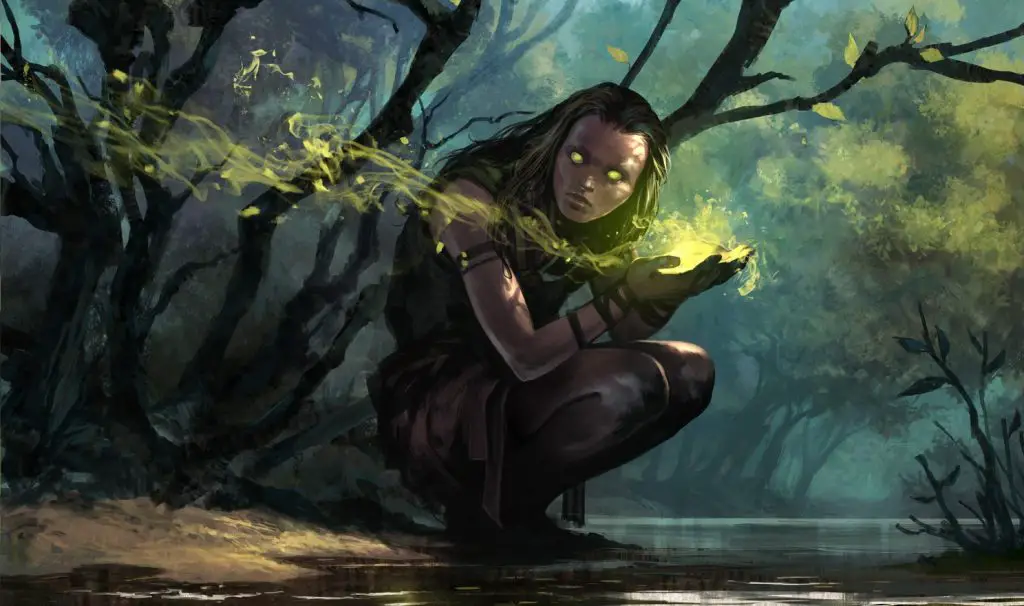
Fungal Infestation (Level 6)
At level 6, the Circle of Spores Druid gains the Fungal Infestation ability. Using this, the Druid reanimates the corpse of a beast or humanoid that dies near it. The creature has to be within 10 feet of the Druid and doing this does require the use of their reaction.
If a beast or humanoid that is a Small or Medium size creature dies within 10 feet of you, you can use your reaction to animate it, causing it to stand up immediately with 1 hit point.
The creature uses the Zombie stat black from the Monster Manual. It remains animate for 1 hour, after which time it collapses and dies.
In combat, the zombie’s turn comes immediately after yours. It obeys your mental commands and the only action it can take is the Attack action, making one melee attack.
You can use this feature a number of times equal to your Wisdom modifier (minimum of once), and you regain all expended uses of it when you finish a long rest.
Fungal Infestation is a thematically cool ability, but the zombies that it creates are pretty much only useful for taking a single hit. Even still, if the zombies don’t get smashed by an enemy, they only last for one hour before collapsing.
But, hey, each attack that your fodder zombies take is one less being thrown at you and your allies, eh?
At later levels (and honestly even at 6th level), this ability is admittedly underwhelming except for some specific utilities. But far be it from me to not see the value and comedy gold of using zombies to check for traps.
Alternatively, the zombies can be used to help block enemy movement. This is especially true in situations where there isn’t mush room to begin with…
Just be mindful that your Reaction is now in high demand.
Do you use it for your Halo of Spores or do you hold onto it in hopes that a nearby enemy will die so that you can use Fungal Infestation?
The choice is yours…
Spreading Spores (Level 10)
At level 10, you can now throw a cluster of your spores to act as a small AoE. Creatures who move through the spores or start their turn there will need to make Constitution saves if they want to avoid damage.
As a bonus action while your Symbiotic Entity feature is active, you can hurl spores up to 30 feet away where they swirl in a 10-foot cube for 1 minute. The spores disappear early if you use this feature again, if you dismiss them as a bonus action, or if your Symbiotic Entity feature is no longer active.
Whenever a creature moves into the cube or starts it turn there, that creature takes your Halo of Spores damage unless it succeeds on a Constitution saving throw against your spell save DC. A creature can take this damage no more than once per turn.
While the cube of spores persists, you can’t use your Halo of Spores reaction.
When used with spells like Entangle that restrict enemies’ movement, this can be very effective. Placed at a chokepoint on the map or used on a cluster of enemies, this can actually be pretty punishing.
Just note that these spores are apparently more aggressive than those you normally have around you.
The feature doesn’t say that the effect excludes your allies (or even you for that matter!), so make sure that you’re not accidentally creating a friendly fire situation.
Fungal Body (Level 14)
Lastly, the Circle of Spores Druid becomes even more resilient at level 14 as the fungal spores have further altered their body.
This is a simple but very impressive capstone feature!
The fungal spores in your body alter you.
You can’t be blinded, deafened, frightened, or poisoned. Any critical hit against you counts as a normal hit instead, unless you are incapacitated.
Ok… WOW!
Especially in your role at the front of the party in combat, all of these benefits are excellent to have.
The worst of the conditions you’re now immune to are Frightened and Blinded. You’ll be quite relentless in combat now! Being immune to being poisoned and deafened is good too, but those aren’t typically huge problems at this level.
But, of course, the real eyebrow-raiser is being immune to critical hits. We’ve all had those games where it seems like the DM just keeps rolling nothing but critical hits. But even if it’s just one critical hit coming your way, it’s nice to just automatically have it count as a normal attack instead.
Just note that critical hits against you while you’re incapacitated will still count as normal though. However, if that happens, you were already in serious truffle… err… trouble to begin with though…
Fungal Body may be a simple effect, but it’s an excellent capstone that really ties up what the Circle of Spores Druid has to offer.
You Might Like: Full Guide to the Druid Class in D&D 5e!
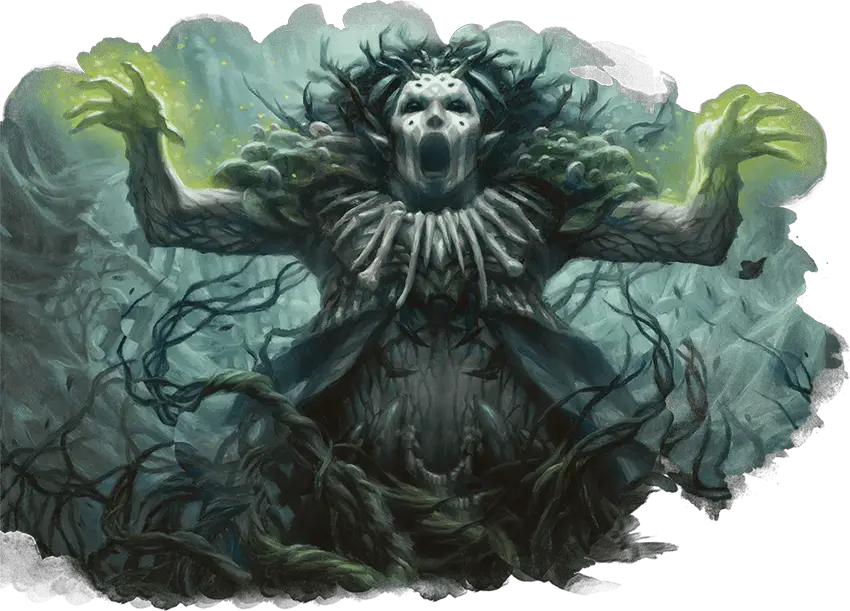
Connections
There is a ton of interesting style and theme that goes in the Circle of Spores Druid. But none of that really inclines towards a character that could be described as “normal”.
But let’s be honest, that’s a huge part of the appeal to this subclass!
Just like mold and fungi can grow seemingly anywhere and take all kinds of unique forms, there’s a limitless number of ways that you can play a Spores Druid and connect them to the party and the story.
Your Spores Druid might be the type of person to have unique perspectives on things.
Where others see rot and death, your character instead sees a unique and powerful type of life that serves an important role in the grand cycle of life and death. Spores Druids could also serve an incredibly important role in dealing with waste and garbage from towns and cities.
When I played a Spores Druid, I took more of a “destiny” angle where it was kind of a freak thing that the spores had latched onto the character who was, otherwise, just a more-or-less regular person.
It was these spores growing in and on him that “unlocked” his Druid powers and he gradually learned more about how to control them and gained an appreciation for a different side of life.
As our adventure would see us going up against Zuggtmoy, the Demon Queen of Fungi, it made for an interesting aspect of “turning the tables” and using her own powers against her.
No different than how fungi can take endlessly unique forms, how you connect to the party and the story will be unique to you.
Sure, the party may have a few morel issues with the Circle of Spores Druid reanimating corpses, but that’s the circle of life for you!
Is the Circle of Spores Druid Good?
Personally, I’m a fan of the Spores Druid for its flavor and unconventional take on the Druid class.
However, it’s definitely different from the typical Druid and the party should not be expecting a large amount of utility from you.
You’ll need to be a bit selfish with your spell selections with more of a focus on keeping yourself in top shape, debuffing enemies, and finding ways to affect the battlefield so you get the best use out of your Halo of Spores each turn.
Spores Druids have a pretty full action economy, so you’ll need to pay special attention to the “risk vs reward” of what you do on each turn. This subclass definitely favors a more aggressive playstyle.
This Circle of Spores Druid really shines in the early-to-mid levels, but it doesn’t have quite the same punch in the late-game.
At low levels, you’re able to get better use out of the Circle of Spores Druid’s unique features. By the late game, the extra bits of necrotic damage become less useful and you’ll definitely start to wish that you could attack more than once.
It takes a couple of turns for the Circle of Spores Druid to really get going, so short combats aren’t particularly their strong suit. But in combats that take more than a few rounds, the Circle of Spores Druid is able to keep applying punishment to enemies.
Add in their ability to reanimate fallen enemies into zombies to absorb enemy attacks, and you’ve got an effective, though unconventional, front-line melee character!
I don’t know that I would consider this one of the top-tier Druid options, but it’s certainly a lot of fun to play! Your party may look at you a little funny at first, but, with your Halo of Spores you’re bound to grow on them…
Also Check Out: Ranking Every Druid Subclass in D&D 5e
Conclusion – The Circle of Spores Druid in D&D 5e
I hope you’ve found this guide to the Circle of Spores Druid in D&D 5e helpful!
As a fun fact, the character that I named this very blog after started out as a Spores Druid. I had a fun time with this subclass and it was pretty funny to see the looks on my friends’ faces as I’d use certain features.
However, due to plot stuff and me beginning to not feel as effective in the mid-levels, I did end up switching subclasses to the Circle of Dreams to be more of a supporting character for the party.
What are your thoughts on the Circle of Spores Druid? Let’s chat in the comments!
Don’t forget to sign up for the Tabletop Joab newsletter! It’s the best way to get all the latest player guides, DM Tips, news, reviews, and more for D&D 5e right to your inbox!
You can also follow me on Facebook and Twitter.
If you found this article helpful and want to support the site, you can buy me a coffee here! (It’s not expected, but very appreciated!)

